DOT Hours of Service Explained:
HOS, ELD, and AOBRD for 2025
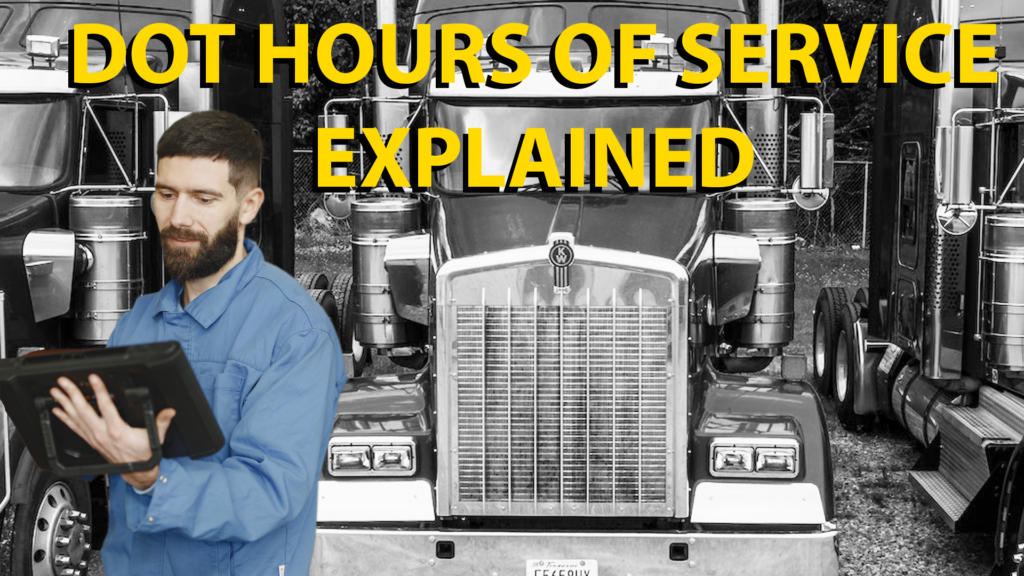
Photo credits: Gustavo Fring and Kelly on Pexels
This blog post is on the United States Hours of Service rules.
NOTE: This article is meant to provide a general overview of the Hours of Service rules. None of this is intended as legal advice. Check with your local FMCSA field office or service center to ensure that you fully understand Hours of Service and how they apply to your ELD system of choice. By reading this post you acknowledge that Telematics 411 will not be held responsible for incorrect use of your ELD system or your interpretation of the information below.
A variation of this article was originally posted on smart-trucking.com (view it here).
This article was previously posted on the Fleet Nav Systems website but has since been removed. Used by permission.
Understanding Hours of Service (HOS)
Chances are if you’ve been in the trucking industry for even just a little while, you’ve heard of Hours of Service (HOS).
In today’s blog we’re going to go over the basics of HOS regulations to give you a practical overview of how they work. We’ll also cut through some of the “alphabet soup” that comes along with these rules—you know what I’m talking about: ELD, AOBRD, EOBR, FMCSA, DOT, RODS, etc. So, let’s get right into it…
What Are the HOS Regulations For?
The point of the Hours of Service (HOS) regulations is to keep tired drivers off the road.
[Whether or not these rules do their job is up for debate, but for now it looks like they are here to stay. Since each driver is legally responsible for his own logs, it is worth brushing up on the rules to remain compliant and keep your compliance, safety, and accountability (CSA) scores up.]
The HOS rules cap the number of hours a driver can be on the road in any given duty cycle so that—in theory—tired drivers are given enough time to rest, eat, sleep, and otherwise be refreshed before they get back on the road.
History
Hours of Service (HOS) has been around for a long time. Since 1938, actually.
There have been multiple versions of these rules over the years, but the ones in effect today were finalized in 2013 and updated with new provisions in September of 2020.
Although they have been regulated by other agencies in the past, the HOS rules are currently mandated by the Federal Motor Carrier Safety Administration (FMCSA), an agency within the United States Department of Transportation (USDOT or DOT).
AOBRDs, ELDs, and How they Relate to HOS
AOBRDs
Automatic On-Board Recording Devices (AOBRDs) were essentially any log-recording device that did not meet the US standard for an Electronic Logging Device (ELD).
AOBRDs were around starting in the 1980s, and then were grandfathered into the December 18, 2017, ELD mandate for the next two years. As of December 16, 2019, AOBRDs were no longer compliant and had to be replaced with ELDs.
ELDs
Electronic Logging Devices (ELDs) are digital log-recording devices that automatically capture your D (Drive) statuses and do a whole bunch of other things (like allow you to electronically transfer your logs during an inspection) to comply with the Federal Motor Carrier Safety Administration’s (FMCSA) 12/18/17 ELD mandate.
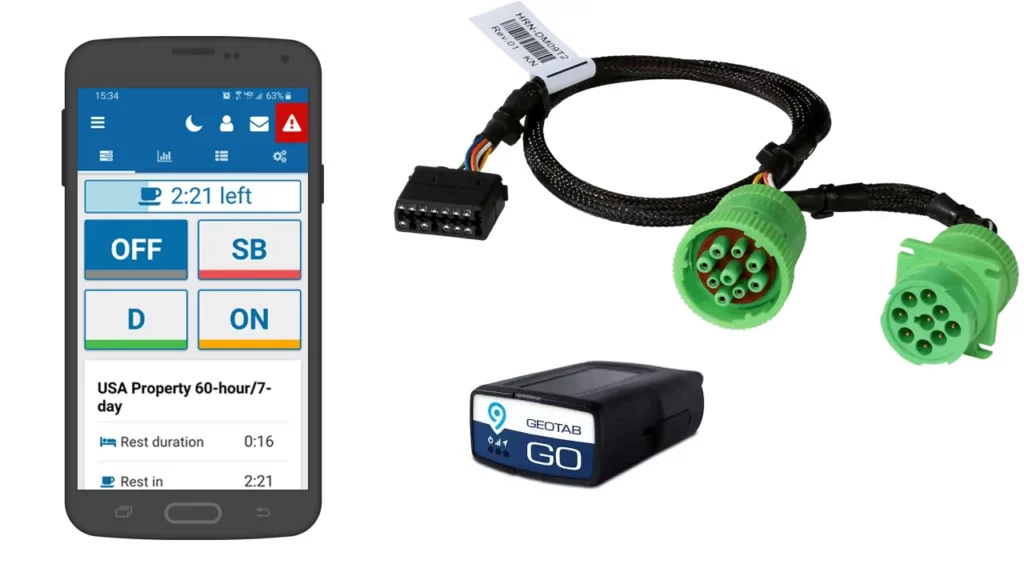
Geotab’s ELD Solution: Geotab Drive App and Hardware (GO Unit and Harness)
And, Why Not? Let’s Cover EOBRs Here, Too…
Another term that you may have heard thrown around is “EOBR”. An EOBR is simply an Electronic On-Board Recorder. Because of a “change of terminology” this acronym is not used within the US Hours of Service law.
Who’s Required to Use ELDs
In general, if you are required to keep Records of Duty Status (RODS), you’re probably required to have an ELD. There are some exceptions to this for:
- Short-haul drivers
- Drivers who keep RODS for fewer than 8 days in a 30-day period
- Drive-away-tow-away operations (where you’re delivering the vehicle you’re driving)
- Vehicles made before the year 2000
Read more about it on the FMCSA’s page here. All drivers in the United States are required to follow these rules, including Canadian and Mexican drivers who cross the United States border to make deliveries.
How HOS Hours Work
In this section we’ll cover the basics of HOS hours. For this example, we’ll cover a standard day for a 60-hour/7-day or 70-hour/8-day ruleset.
Some variations of these hours are considered in the Exemptions section of this blog post, and other variations exist for different rulesets not considered in this post. If you have a question about your ruleset, contact your local DOT service center or field office.
The 14-Hour Window
You’ve got 24 hours in a day for:
- a 14-hour workday, and
- a 10-hour break.
Within your 14-hour workday, you can drive for up to 11 hours. (The extra 3 hours are for breaks, meals, showers, etc.)
Once you start your workday (ON or D status), your clock officially begins counting down and cannot be stopped (except under the updated split-sleeper berth provision explained in the Exemptions section below).
So, your 14-hour window might look something like this:
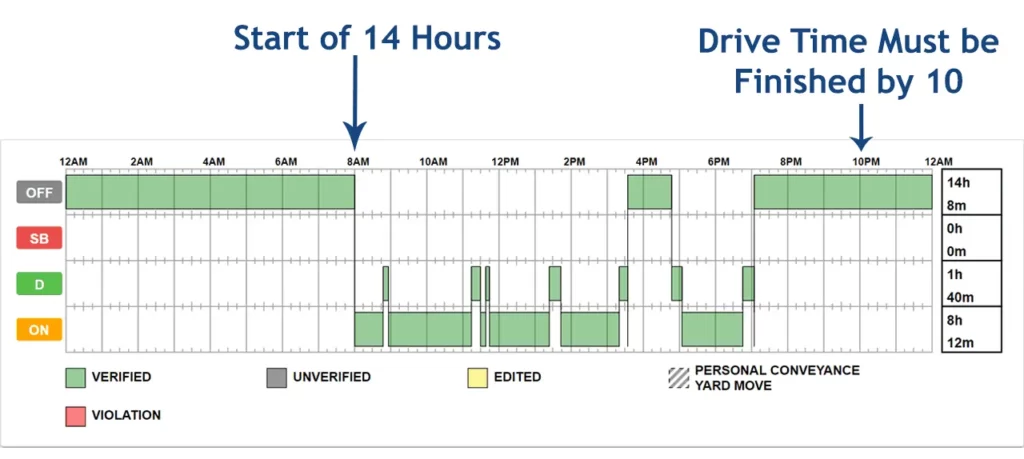
Example: If you start your workday at 8 AM, you must have all your driving finished by 10 PM. If you start at 8 AM and drive after 10 PM, you will be in violation.
Beyond that 14-hour window, you can still work (ON-duty time) but you can’t legally drive again until you take a 10-hour break.
The 30-Minute Break
Depending on your ruleset, you may be required to take a 30-minute break after 8 cumulative hours of driving time.
As of September 29th, 2020, the 30-minute break time must be 30 consecutive minutes of time in an OFF- or ON-duty status.
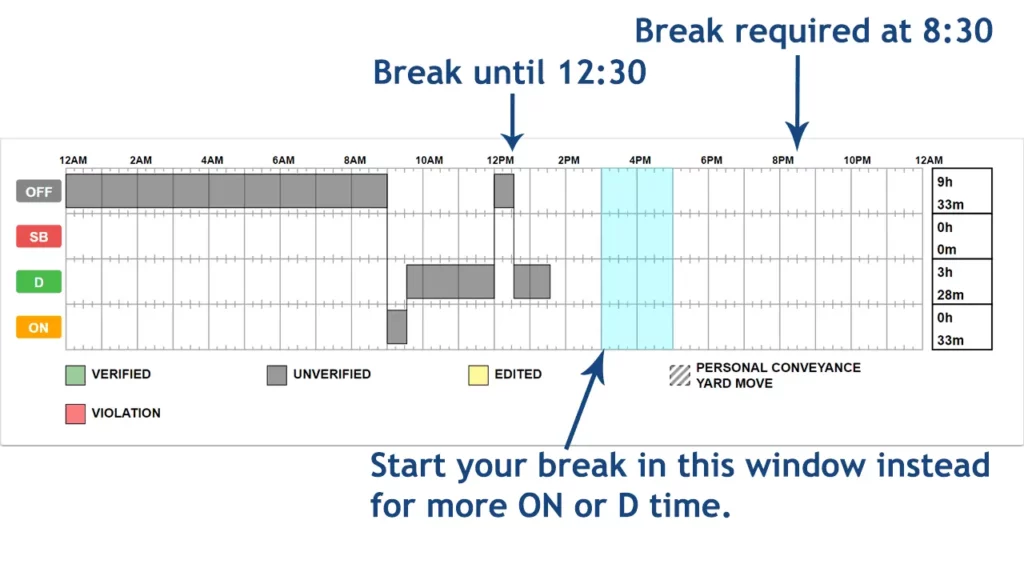
Example: If you start your workday at 10 AM and go ON duty for about 20 minutes in total during short increments throughout your drive time, you still need to take a 30-minute break at some point before you have driven for a total of 8 hours. In the picture above, the driver has satisfied the 30-minute break requirement because he went ON duty for 35 minutes before going back to driving.
Duty Cycles
There are numerous rulesets under the HOS laws for different types of drivers, and which ruleset you’re following will determine your duty cycle.
Two of the more common rulesets for property-carrying drivers are the 60-hour/7-day and 70-hour/8-day, and how their cycles work is almost identical.
For the 60-hour/7-day ruleset, you can have a total of 60 hours of ON-duty and Drive time within a 7-day period.
For the 70-hour/8-day ruleset, you can have a total of 70 hours of ON-duty and Drive time within an 8-day period.
Since the main variation between these two rulesets is the number of days in a cycle, and the 60-hour/7-day rule is probably the easiest to understand, we’ll explain a few main points about cycles in more detail using the 60-hour/7-day as our model.
The 34-Hour Restart
Once every 7 days you can perform a 34-hour restart. This just means that you are OFF duty for a full 34 hours. Once you have spent this time OFF, you will gain your full 60 hours back to start a new 60-hour duty cycle.
Rolling Days in a Duty Cycle
If you prefer not to take 34 hours OFF, you can use rolling days instead. To understand this, consider the following graph.
Let’s say it’s Saturday night, and these are the hours you’ve worked all week:
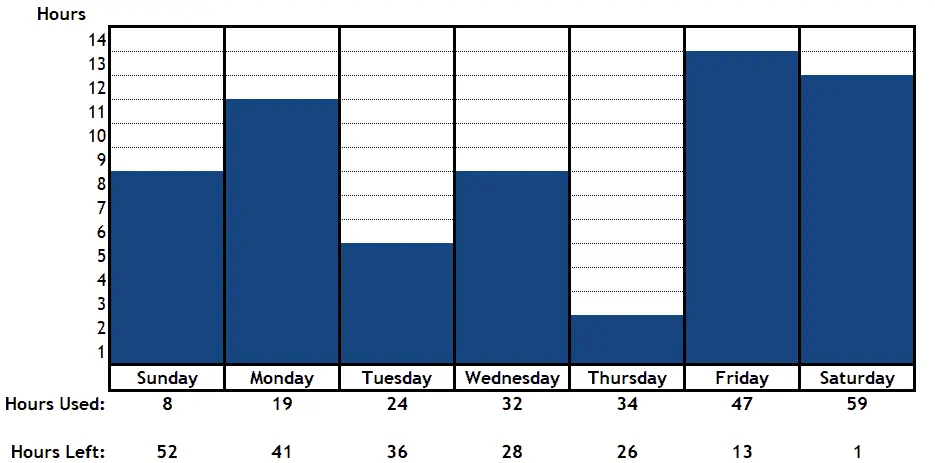
Once midnight on Sunday hits, you will gain back the hours you used the previous Sunday. In this example, that means that you would have 8 hours back on Sunday, plus the 1 hour you had left on your cycle from the week before.
On Monday at midnight, you would gain 11 hours back. On Tuesday at midnight, you would gain 5 hours back. And so on…
NOTE: Just because you gain hours back at midnight does not mean that you can begin driving again at midnight. For example, if you ended your shift at 8 PM on Saturday night, you would still need your full 10-hour break to be able to start driving again at 6 AM on Sunday morning.
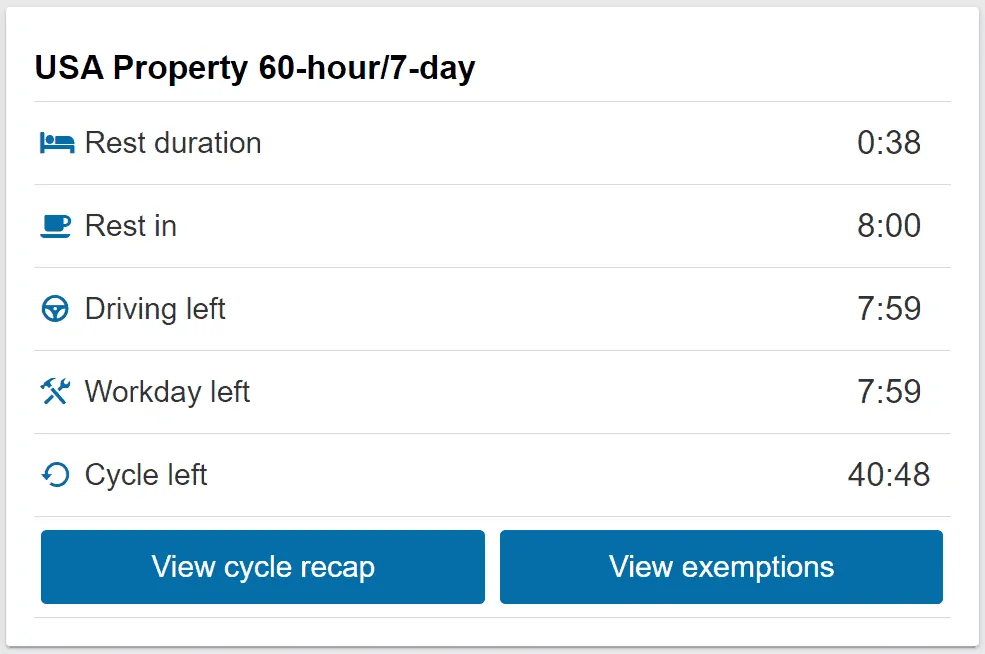
Sample Countdown Timer with Cycle Time Left from the Geotab Drive App
Duty Statuses
You’ve got four different duty statuses, each logged on one of four lines:
- D (Drive)
- ON
- OFF
- SB (Sleeper Berth)

RODS Graph in the Geotab Drive App
D (Drive)
This status is for when you are behind the wheel driving faster than 5 MPH (which is pretty much any time you’re driving).
ON
This is any time you are working but not behind the wheel going over 5 MPH. So, this can be if you’re:
- Filing paperwork
- Loading or unloading
- Supervising loading or unloading
- Responsible for a load in general
- Working at another job
These are just a few examples of what is considered ON-duty time.
One of the more interesting “gotchas” for an ON-duty status is that ON is technically any time you are working:
If you have a side gig outside of your trucking job, any time at your other job counts as ON-duty time. Of course, this makes sense, since the point of the HOS rules is to keep tired truckers off the road.
OFF
This is any time you spend that you do not meet the requirements for any of the other statuses (that is, whenever you’re not ON, Driving, or in the Sleeper Berth).
SB (Sleeper Berth)
This is any time that you are in the sleeper berth.
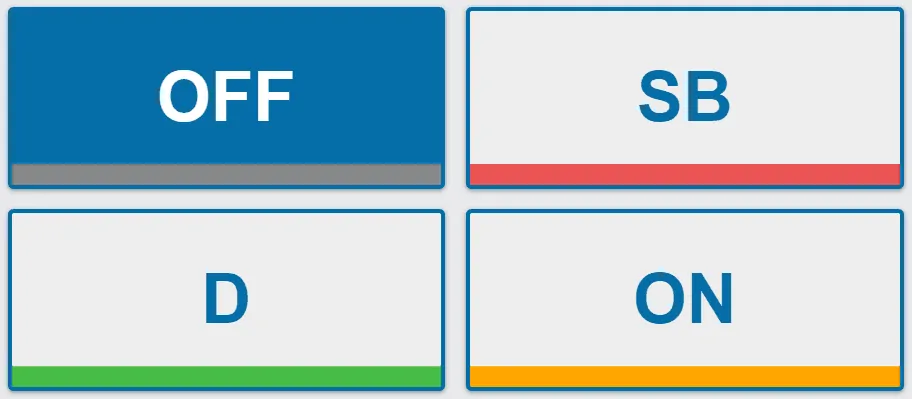
Duty-Status Buttons in the Geotab Drive App with OFF Selected
Exemptions
With ELDs we got some new exemption statuses.
Whereas you may have been able to record your personal driving on the OFF line on paper logs, or considered yourself ON or OFF while in a yard, there’s now the added data with ELDs to show whenever you’ve been driving, and you have to account for this time.
Exemption Statuses
One of the main things to remember when applying an exemption on an ELD is that you cannot apply one retroactively.
Example: You drive on your company’s yard as “Yard Move” time, but forget to change your status to “Yard Move”. You can’t go back and add a “Yard Move” status to those logs, instead you will have to annotate them to explain that they are in error.
This rule exists to help avoid cheating on logs. Make sure you apply exemptions when you are supposed to be because a continuous pattern of annotations explaining these kinds of mistakes may look like cheating or log-hiding to an officer inspecting your logs.
Yard Move (YM)
Yard Move (YM) can be applied any time you’re driving off of public roads. This exemption will keep you ON duty while you are driving over 5 MPH so you aren’t losing any of your Drive time while maneuvering your vehicle around a company’s lot.

What a Yard Move Status Looks Like in the Geotab Drive App
Personal Conveyance (PC)/Personal Use
Personal Conveyance (PC) can be applied any time you’re driving for personal reasons and not advancing the load you’re hauling. This would be for driving to and from dinner after you’ve checked into a hotel, finding the nearest safe place to park for a break after your delivery, etc.
This was redefined by the FMCSA in 2019 to make it more flexible than it was originally when written for the 2017 ELD Mandate.
Although no specifications have been given as to what is a “reasonable distance” traveled under PC (the legal terminology used to explain how far you’re allowed to drive under the exemption), you need to ensure that you annotate your logs to explain where you went under this exemption and why.
In other words, if you traveled 250 miles on PC, that could be easily seen in an audit, and you’d better have a really good reason for it!
Depending on your ELD provider’s features, your company may be able to set a maximum distance you can drive in PC on a given day. In these cases, your ELD may switch you back into Drive automatically if you exceed the limit set by your company.
Geotab’s ELD solution allows administrators to set a maximum PC distance for all drivers, and will automatically switch drivers back into D status if they exceed that limit.
The other thing to keep in mind is that PC stops as soon as you cut the ignition on your vehicle. So, if you drive to a restaurant in PC, turn off your vehicle and go eat a meal, and then come back to drive to your hotel for the night, you’ve gotta make sure that you put yourself back into PC before you start driving or you’ll be put into Drive status.
This could seriously impact your time if you are on a 10-hour break!
NOTE: DOT officers have said that the most common way that drivers try to cheat on their logs is to put themselves into PC when they should not be in this status. Because of this, officers are often on the lookout for this kind of log hiding.
Adverse Weather
This exemption extends your Drive time from 11 hours to 13 hours and your workday from 14 to 16 hours in cases where you encounter weather (e.g. rain, snow, sleet) or traffic conditions that were not known to exist ahead of time.
REMINDER: This is for the US Hours of Service rules; the Adverse Weather exemptions for Canada are different.
What if You Forget to Apply an HOS Exemption on Your ELD?
In short, don’t panic.
If you forgot to apply an exemption, you can simply annotate your D and ON logs to explain that you should have been in whichever exemption status you should have chosen.
NOTE: Do not do this unless you *really* should have been in an exemption status; if you try to cheat on your logs, this is usually pretty easy to determine based off of your GPS-location records.
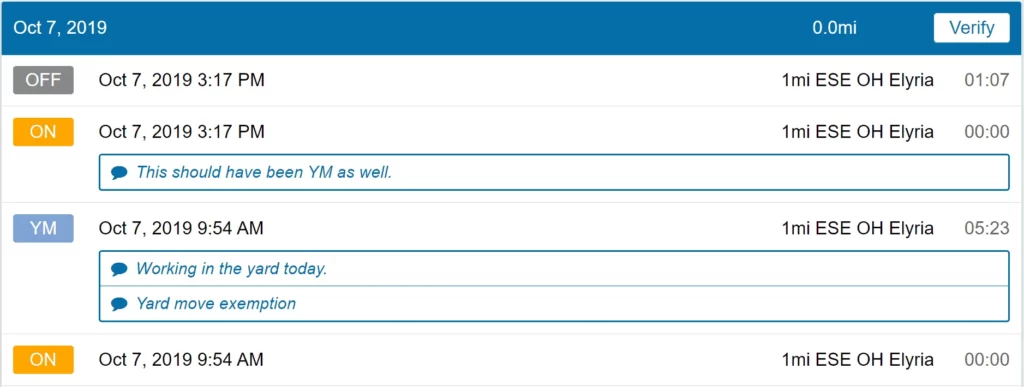
Sample Logs with Annotations in the Geotab Drive App
The one downside to messing up your exemption statuses is that it may show up on your time clock and show that you are still out of hours until you take a full 10-hour break.
In these cases, you may have to manually keep track of your hours outside of your ELD. Depending on your ELD provider, you may have the ability to ignore erroneous logs so that your time clock isn’t messed up.
Geotab has an “Ignore” feature for logs that lets an administrator mark logs to be ignored. The logs still show the violations (along with any annotations you’ve made to explain why they shouldn’t be counted as violations), but the time clock will ignore these so that your ELD will continue to count down your hours without your having to do it manually.
Industry Exemptions
There are many different industry exemptions for HOS. Here we cover just a couple of the more common ones you may come across.
Short-Haul Exemption
If you stay within a 150 air-mile radius of your home terminal, you may qualify to run on this exemption. This ruleset limits you to 11 hours of driving within a 14-hour day, requires no break and no paperwork.
NOTE: If you leave the 150 air-mile radius or go over the 14-hour workday limit, you are required to keep logs. If you go out of the radius sometimes, it is probably best to keep logs all the time, as once you leave the radius you should have your logs for the previous days’ driving to remain compliant.
16-Hour Exemptions
If you’re not longhaul or over-the-road (OTR), the 16-hour exemption may be available to you. This allows one 16-hour workday every duty cycle if you’ve started and ended your day at the same terminal for the previous 5 days.
What’s the Takeaway Here?
The ELD Mandate looks like it is here to stay. Knowing the rules when it comes to HOS is important for keeping yourself compliant and on the road making money.
For further reading, check out some of these other resources:
- Hours of Service on Wikipedia
- FMCSA’s ELD FAQs
- FMCSA’s 2016 Interstate Truck Driver’s Guide to Hours of Service
If your company is looking for an ELD solution and you’re not sure which one(s) might be a good fit, reach out. I can make recommendations on Geotab resllers based on your company’s needs.
Check out Telematics 411 on YouTube, visit the website for more information, or email me at joy@telematics411.com.